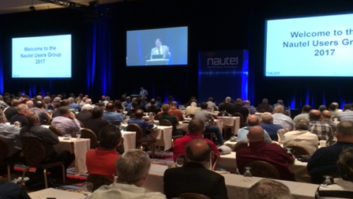CALABASAS, Calif.� The earlier rollout of HD Radio services on the U.S. AM radio band was abortive; but that experience involved only the so-called hybrid mode of HD Radio. Now the company that makes the technology thinks the expanded part of the AM band (1605�1705 kHz) would be a good place for the industry to introduce all-digital broadcasts.
�
DTS Inc. filed comments in the FCC�s AM revitalization proceeding and said it is prepared to work with the commission and broadcasters to develop technical rules to guide the introduction of all-digital service. It thinks a notice of proposed rulemaking on the subject is in order.�
�
It said it agrees in general with an FCC proposal �to make greater use of the expanded band,� and it said this part of the spectrum offers a lower-interference environment that could help address listener complaints about AM broadcasting.�
�
�It also provides a unique opportunity for the commission to allow broadcasters to introduce all-digital broadcasts that would help eliminate much of the interference that plagues the AM band,� the company wrote.�
�
The AM all-digital system, DTS says, was designed to help reduce interference from co- and adjacent-channel stations, and it would give broadcasters the ability to offer FM-quality sound that can support robust music formats on the AM band.�
�
�Higher-quality audio allows AM broadcasters to attract listeners that have turned to other sources of audio entertainment due to the limitations of analog AM,� it wrote. �All major automobile manufacturers in the United States offer HD Radio receivers in their vehicles, and a significant percentage of vehicles on the road include digital receivers, making all-digital broadcasts economically feasible.�
�
Hybrid-mode AM broadcasts would bring audio quality enhancements, the company said; but beyond that, all-digital broadcasting would offer further benefits. �The main constraints confronting AM broadcasters using the hybrid mode of the HD Radio system are interference from analog broadcasts to the digital signal and the need to constrain digital operations in order to protect existing analog operations. The all-digital AM system eliminates these problems.�
�
Because all-digital AM HD Radio moves digital energy to the center of the channel, it said, the overlap between adjacent signals is reduced, as is adjacent-channel interference. �The absence of an analog signal eliminates host analog interference to the digital signal, thereby extending the range of AM digital broadcasts.��
�
If the commission finds insufficient industry support for all-digital broadcasts right now, DTS said, the FCC should at least require that any new stations introduced in the expanded band include hybrid digital broadcasts.�It would be illogical to introduce new AM broadcasts that cannot offer the highest quality audio experience for listeners and that would require additional upgrades in the future in order to provide digital service. Requiring digital service from the beginning will help the commission to ensure the longer-term viability and relevance of any new stations introduced in the expanded bands.�
DTS also asked the commission to ensure that changes to AM technical rules do not �negatively impact� the rollout of HD Radio broadcasting. It said proposals to change nighttime protection for Class A AM stations and daytime protection to Class B, C and D stations could affect digital operations.�
�
�Eliminating the existing nighttime protections would eliminate the need for digital stations to provide protection for Class A stations, however, the introduction of additional AM stations or the increase in local nighttime broadcasts by existing stations has the potential to increase nighttime interference that would negatively impact digital operations,� it wrote.�
�
�Similarly, although the daytime protection ratio for Class B, C and D stations existed prior to 1991, the commission�s experience with those protection ratios predates the introduction of digital service. DTS is concerned that increases in analog power could increase interference levels and thereby decrease digital service.�
�
Albert Shuldiner, senior vice president and associate general counsel for DTS, authored its comments.�
�
This article was originally posted on the website of Radio World, sister publication of Radio magazine.�
�
�












